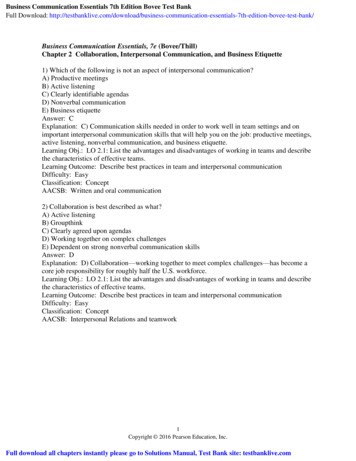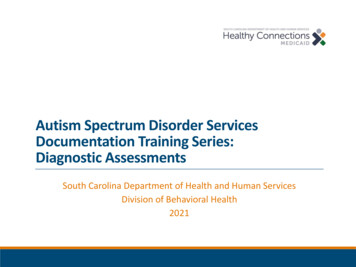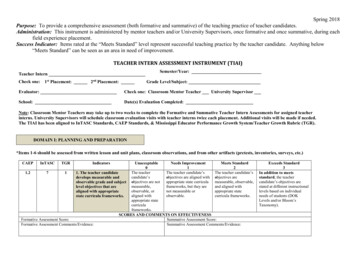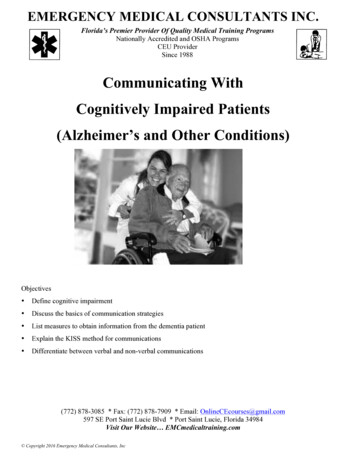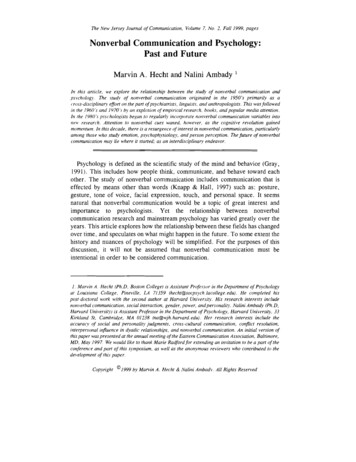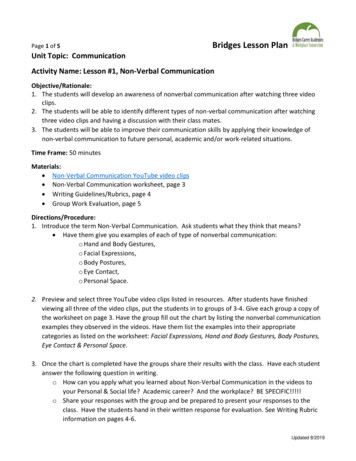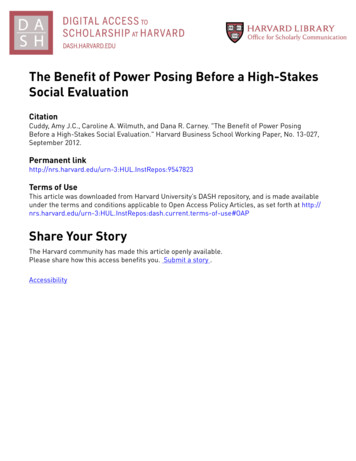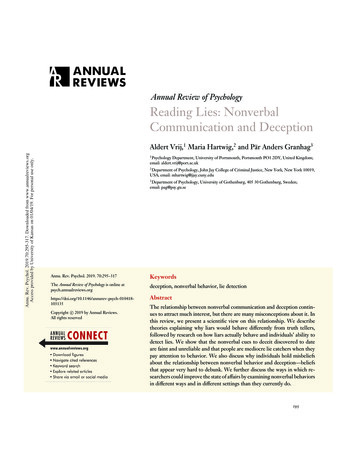
Transcription
PS70CH13 VrijARI8 November 201812:59Annual Review of PsychologyReading Lies: NonverbalCommunication and DeceptionAnnu. Rev. Psychol. 2019.70:295-317. Downloaded from www.annualreviews.orgAccess provided by University of Kansas on 01/04/19. For personal use only.Aldert Vrij,1 Maria Hartwig,2 and Pär Anders Granhag31Psychology Department, University of Portsmouth, Portsmouth PO1 2DY, United Kingdom;email: aldert.vrij@port.ac.uk2Department of Psychology, John Jay College of Criminal Justice, New York, New York 10019,USA; email: mhartwig@jjay.cuny.edu3Department of Psychology, University of Gothenburg, 405 30 Gothenburg, Sweden;email: pag@psy.gu.seAnnu. Rev. Psychol. 2019. 70:295–317KeywordsThe Annual Review of Psychology is online atpsych.annualreviews.orgdeception, nonverbal behavior, lie 418103135Abstractc 2019 by Annual Reviews.Copyright All rights reservedThe relationship between nonverbal communication and deception continues to attract much interest, but there are many misconceptions about it. Inthis review, we present a scientific view on this relationship. We describetheories explaining why liars would behave differently from truth tellers,followed by research on how liars actually behave and individuals’ ability todetect lies. We show that the nonverbal cues to deceit discovered to dateare faint and unreliable and that people are mediocre lie catchers when theypay attention to behavior. We also discuss why individuals hold misbeliefsabout the relationship between nonverbal behavior and deception—beliefsthat appear very hard to debunk. We further discuss the ways in which researchers could improve the state of affairs by examining nonverbal behaviorsin different ways and in different settings than they currently do.295
PS70CH13 VrijARI8 November 201812:59ContentsAnnu. Rev. Psychol. 2019.70:295-317. Downloaded from www.annualreviews.orgAccess provided by University of Kansas on 01/04/19. For personal use only.READING OTHERS . . . . . . . . . . . . . . . . . . . . . . . . . . . . . . . . . . . . . . . . . . . . . . . . . . . . . . . . . . . . .READING DECEPTION AND TRUTH . . . . . . . . . . . . . . . . . . . . . . . . . . . . . . . . . . . . . . . . .DETECTING DECEPTION THROUGH NONVERBAL BEHAVIOR . . . . . . . . . .WHY WOULD TRUTH TELLERS AND LIARS DISPLAY DIFFERENTBEHAVIORS? THEORIES OF NONVERBAL CUES TO DECEPTION . . . . . .Mental Process Theories: Emotion and Cognition . . . . . . . . . . . . . . . . . . . . . . . . . . . . . . .Social Psychological Approaches: Interpersonal and Contextual Theories . . . . . . . . . .NONVERBAL CUES TO DECEPTION: THE EVIDENCE . . . . . . . . . . . . . . . . . . . . .PSEUDOSCIENTIFIC LIE DETECTION . . . . . . . . . . . . . . . . . . . . . . . . . . . . . . . . . . . . . . .The Behavior Analysis Interview . . . . . . . . . . . . . . . . . . . . . . . . . . . . . . . . . . . . . . . . . . . . . . . .Facial Microexpressions . . . . . . . . . . . . . . . . . . . . . . . . . . . . . . . . . . . . . . . . . . . . . . . . . . . . . . . . .Neurolinguistic Programming . . . . . . . . . . . . . . . . . . . . . . . . . . . . . . . . . . . . . . . . . . . . . . . . . . .The Baseline Approach . . . . . . . . . . . . . . . . . . . . . . . . . . . . . . . . . . . . . . . . . . . . . . . . . . . . . . . . .HOW DO THE CUES RELATE TO THE THEORETICALPERSPECTIVES? . . . . . . . . . . . . . . . . . . . . . . . . . . . . . . . . . . . . . . . . . . . . . . . . . . . . . . . . . . . . .REASONS WHY NOT MANY DIAGNOSTIC CUES TO DECEITHAVE BEEN FOUND TO DATE . . . . . . . . . . . . . . . . . . . . . . . . . . . . . . . . . . . . . . . . . . . . .Some Cues Are Overlooked . . . . . . . . . . . . . . . . . . . . . . . . . . . . . . . . . . . . . . . . . . . . . . . . . . . . .Unprecise Measurements . . . . . . . . . . . . . . . . . . . . . . . . . . . . . . . . . . . . . . . . . . . . . . . . . . . . . . .Idiosyncratic Behavior . . . . . . . . . . . . . . . . . . . . . . . . . . . . . . . . . . . . . . . . . . . . . . . . . . . . . . . . . .A Cluster of Cues May Be More Diagnostic . . . . . . . . . . . . . . . . . . . . . . . . . . . . . . . . . . . . . .Situational Differences . . . . . . . . . . . . . . . . . . . . . . . . . . . . . . . . . . . . . . . . . . . . . . . . . . . . . . . . . .Contagious Behaviors . . . . . . . . . . . . . . . . . . . . . . . . . . . . . . . . . . . . . . . . . . . . . . . . . . . . . . . . . . .Strategies Employed by Truth Tellers and Liars . . . . . . . . . . . . . . . . . . . . . . . . . . . . . . . . .ACCURACY IN LIE DETECTION THROUGH OBSERVINGNONVERBAL CUES. . . . . . . . . . . . . . . . . . . . . . . . . . . . . . . . . . . . . . . . . . . . . . . . . . . . . . . . . .INDIVIDUALS’ VIEWS ON THE RELATIONSHIP BETWEEN NONVERBALBEHAVIOR AND DECEPTION . . . . . . . . . . . . . . . . . . . . . . . . . . . . . . . . . . . . . . . . . . . . . .WHY INDIVIDUALS CONTINUE TO MAKE NONVERBALLY BASEDVERACITY ASSESSMENTS . . . . . . . . . . . . . . . . . . . . . . . . . . . . . . . . . . . . . . . . . . . . . . . . . .Little Choice Other than to Observe Behaviors . . . . . . . . . . . . . . . . . . . . . . . . . . . . . . . . . .Lack of Self-Insight . . . . . . . . . . . . . . . . . . . . . . . . . . . . . . . . . . . . . . . . . . . . . . . . . . . . . . . . . . . . .The Power of Stereotypes . . . . . . . . . . . . . . . . . . . . . . . . . . . . . . . . . . . . . . . . . . . . . . . . . . . . . . .Culturally Transmitted Misbeliefs . . . . . . . . . . . . . . . . . . . . . . . . . . . . . . . . . . . . . . . . . . . . . . .FUTURE DIRECTIONS IN NONVERBAL DECEPTION RESEARCH . . . . . . . . .CONCLUDING REMARKS . . . . . . . . . . . . . . . . . . . . . . . . . . . . . . . . . . . . . . . . . . . . . . . . . . . . 05306306306307307308308309310311311311312READING OTHERSLife is so full of encounters with other humans that we tend to take these encounters for granted.Often, social interactions run fairly seamlessly, and we do not spend much time reflecting on theiromnipresence or plumbing the depths of how they actually work. Scholars, however, have takenon the task of trying to understand social interaction in all its complexity. There is now a vast bodyof scientific literature on this topic spanning multiple disciplines, including psychology, sociology,anthropology, linguistics, and philosophy.296Vrij·Hartwig·Granhag
PS70CH13 VrijARI8 November 201812:59Annu. Rev. Psychol. 2019.70:295-317. Downloaded from www.annualreviews.orgAccess provided by University of Kansas on 01/04/19. For personal use only.When we interact with others, we make judgments of the other person’s state of mind—we tryto read their emotions, thoughts, needs, and intentions. This makes sense because knowing whatis going on in another person’s head can be used both to coordinate cooperative interactions andto gain advantage in competitive ones.A nondisputed claim in psychology is that mind reading (i.e., making inferences about another’sstate of mind) is central to social interactions. The psychological picture of humans painted bymodern social and cognitive psychology is that of chronic mind readers who constantly engagein rapid and partly automatic evaluation of the mental states of other people. How good are we,then, at accurately reading minds? The major finding from research is that we are not as good atreading other people as we think. We are not operating in complete darkness, but we vastly andconsistently overestimate our skills (Epley 2014). This is an arresting finding that cuts to the heartof our beliefs about ourselves as social agents.READING DECEPTION AND TRUTHIf mind reading is inaccurate in everyday life, then it might lead to confusion, misunderstandings,and unnecessary conflict between individuals. Faulty mind reading can also have catastrophic consequences for individuals or for society as a whole. Deception is such an example where misjudgments can be costly. Nobody knows how many innocent people have suffered unjust punishmentbecause others have judged them to be guilty, but we do know that this problem is substantial(Garrett 2011, Scheck et al. 2003). In addition, thousands of people have died in terrorist attacksthat could have been prevented if the deceptions involved in executing the attacks had been detected. So, in contrast to casual social judgments, judgments of deception and truth can literallybe a matter of life and death.There is an extensive body of work on deception and its detection. In this article, we offer anoverview and a critical discussion of this literature and focus on the role of nonverbal behavior intelling and reading lies. We do so because, unlike verbal or physiological lie detection, judgementsof nonverbal behavior can be made in every social encounter. Nonverbal lie detection is also a domain where many myths continue to exist: People typically overestimate the relationship betweendeception and nonverbal behavior and the ability to detect deceit by observing nonverbal behavior.Two Annual Review of Psychology articles about deception precede this article. Hyman’s (1989)theoretical contribution made us aware of how much the publication of deception research hasincreased over the past three decades. Hyman covered the period between 1966 and 1986. UsingSCOPUS search software with key words “lie detection” or “deception,” we found 415 psychologyarticles for this period, an average of 20.75 per year. In the year 2016 alone, we found 206psychology articles, almost ten times as many. More recently, Pennebaker et al. (2003) publishedan article that included deception, but it focused on word use rather than nonverbal behavior.In other words, this is the first Annual Review of Psychology article about nonverbal behavior anddeception. We provide a comprehensive overview and rely on seminal publications in this field.DETECTING DECEPTION THROUGH NONVERBAL BEHAVIORThe notion that lies are transparent and can be detected through nonverbal behavior dates backa long time. As early as 900 BC, it was claimed that liars shiver and engage in fidgeting behaviors(Trovillo 1939a). In 1908, Münsterberg pointed to the utility of observing posture, eye movements,and knee jerks for lie detection purposes (Trovillo 1939b). Famously, Freud (1959, p. 94) wrote:“He who has eyes to see and ears to hear may convince himself that no mortal can keep a secret.If his lips are silent, he chatters with his finger-tips; betrayal oozes out of him at every pore.”www.annualreviews.org Nonverbal Communication and Deception297
PS70CH13 VrijARI8 November 201812:59Theories on nonverbal behaviorand deceptionMental processesEmotionCognitionCognitive loadAnnu. Rev. Psychol. 2019.70:295-317. Downloaded from www.annualreviews.orgAccess provided by University of Kansas on 01/04/19. For personal use only.Social psychological heoryMoral psychologytheoryStrategic modelsFigure 1Theories of nonverbal behavior and deception.Popular culture reflects the enduring belief that liars give themselves away through nonverbalbehavior. For example, there are numerous books aimed at a popular audience recommendingways to decipher deception based on demeanor (e.g., Houston et al. 2012, Meyer 2010). Also, thebasic mythology of the leaky liar is integrated into American police interrogation manuals (Vrij &Granhag 2007). The belief in the detectability of lies is also built into many legal presumptions—for example, jurors in criminal cases are often asked to pay attention to the defendant’s nonverbalbehavior to assess their truthfulness (Sporer & Schwandt 2006, Vrij & Turgeon 2018).The relationship between nonverbal behavior and deception intrigues people and representsbig business. In this article, we review what is currently known about this topic. We discuss theoriesabout why liars and truth tellers would display different behaviors and then review research onactual nonverbal cues to deception. As we describe, research consistently shows that attemptingto read truth and deception results in very poor accuracy rates, most likely because the behavioraltraces of deception are faint.WHY WOULD TRUTH TELLERS AND LIARS DISPLAY DIFFERENTBEHAVIORS? THEORIES OF NONVERBAL CUES TO DECEPTIONThere are many theories explaining the relationship between nonverbal behavior and deception(Figure 1). We do not offer an overview of past distinctions between these theoretical views (forsuch an overview, see Bond et al. 2015). Instead, we restructure the theoretical discussion andoffer a reclassification of deception theories. Our rationale for this restructuring is that the fieldof deception has grown significantly since many of the classic conceptualizations were launched(Zuckerman et al. 1981), and that both social and cognitive psychology, on which deception theoryis ultimately based, have undergone major theoretical developments (Fiske & Taylor 2013).Mental Process Theories: Emotion and CognitionOne cluster of theories about nonverbal behavior and deception deals with the mental processesthat are involved in producing a deceptive statement. These mental process theories share thepremise that the most fruitful approach to understanding the overt behavior of a liar is to inspect298Vrij·Hartwig·Granhag
PS70CH13 VrijARI8 November 201812:59Annu. Rev. Psychol. 2019.70:295-317. Downloaded from www.annualreviews.orgAccess provided by University of Kansas on 01/04/19. For personal use only.the internal processes that occur when lies are told. A critical distinction within such theories isthat some focus on emotional processes and others on cognitive processes.Emotional theories. Ekman & Friesen (1969) presented the first modern theoretical conceptualization of nonverbal behavior and deception. Drawing on psychoanalytic models of the unconscious and early Darwinian theories of emotion, they hypothesized that a failure to completelysuppress emotions associated with deception—anxiety, fear or even delight at the prospect ofsuccessful deceit—could result in nonverbal cues (the so-called leakage hypothesis). Such leakagecues could appear in various nonverbal channels, such as the face, arms or hands, and legs or feet.Ekman’s (1985) theory about deceptive leakage has been highly influential in the popularmedia, even spawning a major network show (Lie to Me) supposedly partly based on Ekman’s lifeand work. However, Ekman’s claims have been highly criticized in the scientific community (Bondet al. 2015, Lindquist et al. 2012). The problem with Ekman’s emotional theory is that it lacks cleardefinitions of what emotions liars are supposed to feel and when. Moreover, why would a truthteller in the same situation not experience the same emotions? To put it differently, the theoryconfounds emotion and deception (Nat. Res. Counc. 2003). Partly in reaction to the problems ofemotional theory, recent theories have focused on the cognitive processes underlying deception.Cognitive theories. The notion that liars and truth tellers would differ in cognitive processesdates back to Zuckerman et al.’s (1981) seminal paper. Over the past decade, cognitive theoriesof deception have come to dominate the conceptual landscape. These theories generally rejectthe utility of focusing on liars’ emotions. Instead, they seek to understand how and when lying ismore cognitively taxing than telling the truth and how such cognitive load might manifest itselfin nonverbal behavior.Cognitive load theory. Vrij and colleagues (2008a, 2016, 2017a) have built a substantial body ofwork around the notion that, in interview settings, lying may be more cognitively demanding thantelling the truth, which subsequently can be exploited for the purpose of lie detection. Vrij et al.(2008b) suggested a number of reasons why differences in cognitive load between liars and truthtellers may occur. For example, it may be that formulating a lie is more difficult than drawing atruthful account from memory. For a lie to be believable, it has to contain sufficient details tobear the characteristics of a self-experienced event. Offering details that sound plausible requiresimagination, and liars may lack such imagination. In addition, offering details may be risky if thetarget of the lie has information that contradicts the liar’s claims (Nahari et al. 2014).Furthermore, truth tellers appear to take their credibility for granted in ways that liars donot. For example, truth tellers often express the belief that if they simply tell the truth the way ithappened, their innocence will become apparent to their communication partner (Kassin 2005,Strömwall et al. 2006). If liars are more prone to believe that their credibility is in jeopardy, theyought to expend more effort to come across as believable. Finally, whereas activating the truthoften happens automatically, activating a lie is more intentional and deliberate and thus requiresmental effort (Gilbert 1991, Walczyk et al. 2003). Although these are good reasons to believe thatlying places a stronger burden on cognitive resources than telling the truth, lying may not giverise to clear cues in itself—it seems that specific interview protocols are required for clear cues toemerge (Vrij et al. 2017a).Strategic models. Strategic models make up another branch of cognitive theories of deception.These models view the psychology of deception as a kind of game that demands many strategicdecisions from the liar. They draw partly on Hilgendorf & Irving’s (1981) classic model of thewww.annualreviews.org Nonverbal Communication and Deception299
PS70CH13 VrijARI8 November 201812:59psychology of suspects’ decision making: People who have incriminating information to concealare faced with strategic choices about what information to admit to, what information to conceal,and what information to deny. Other researchers have elaborated on this notion, primarily inrelation to strategic interviewing techniques (Granhag & Hartwig 2008). The most importantpoint is the model’s emphasis on liars’ psychology as being driven by planning, strategizing, andcalculation. Research has shown that insight into liars’ interview strategies facilitates lie detectionas long as investigators use specific interview techniques aimed to exploit these strategies [e.g.,cognitive credibility assessment (Vrij et al. 2017a), strategic use of evidence (Granhag & Hartwig2015), and the verifiability approach (Nahari 2018)].Social Psychological Approaches: Interpersonal and Contextual TheoriesAnnu. Rev. Psychol. 2019.70:295-317. Downloaded from www.annualreviews.orgAccess provided by University of Kansas on 01/04/19. For personal use only.The social psychological approaches to understanding nonverbal behavior in deception share theview that deceptive (and truthful) behavior occurs in a social context, in alignment with Lewin’s(1943) notion that behavior is a function of the person and the environment. In this section, wefocus on three theories that are based on this idea.Interpersonal deception theory. Interpersonal deception theory (IDT) states that deception isa dynamic interaction between senders and receivers of messages (Buller & Burgoon 1996). Thismay sound trivial, but prior to IDT, research paradigms rarely reflected the interactive nature ofdeception. IDT further states that deception unfolds in time: Senders monitor the behavior ofreceivers and vice versa, and they mutually adjust their behavior in accordance with the feedbackthat they receive from each other. Plausible as this may seem, IDT has been criticized on thegrounds that it is conceptually underdeveloped and that it fails to generate testable hypotheses(DePaulo et al. 1996).Self-presentational theory. Drawing on Goffman’s (1959) classic work on social behavior inordinary life, DePaulo (1992) proposed a theory of the psychology of deception in which lying isnot an extraordinary form of social behavior, qualitatively different from other forms of conduct.Following Goffman (1959), who pointed out that life is like a theater and that people often behaveas actors on a stage, DePaulo suggested that most social behavior is not raw; instead, people edit,groom, and adjust how they come across to others to pursue a variety of social goals. Such editingmay occur on both verbal and nonverbal levels.In the self-presentational view of deception, liars and truth tellers share a common goal: tocome across as truthful. To achieve this goal, both liars and truth tellers may engage in deliberate(and automatic) self-presentational efforts and in similar forms of behaviors to create a credibleimpression (Feldman et al. 2002, Weiss & Feldman 2006). This is a radical theory of deceptionbecause it emphasizes the similarities between lying and truth telling rather than the characteristicsunique to deception. However, DePaulo (1992) also points out that there is a critical differencebetween the two activities: Both liars and truth tellers make claims of honesty, but in contrast totruth tellers, liars know that their claims are illegitimate. This so-called deception discrepancy maygive rise to cues to deception, in that liars embrace their stories to a lesser extent and experiencea more pronounced sense of deliberateness.Moral psychology theory. As a theoretical framework for their seminal meta-analysis on accuracy in lie judgments, Bond & DePaulo (2006) introduced a new view of deception that emphasized the moral psychological elements of lying and judging lies. They proposed the doublestandard hypothesis, which suggests that people have two sets of moral standards regarding the300Vrij·Hartwig·Granhag
PS70CH13 VrijARI8 November 201812:59acceptability of lies: When we imagine ourselves being the target of deception, lying is a moraloffense. However, when we ourselves tell a lie, we trivialize the seriousness of our behavior andreadily generate justifications. Recall Ekman’s (1985) emotional theory that liars might experienceguilt and shame. In Bond and DePaulo’s view, this may be nothing more than a projection, inthat we think that we ought to experience such emotions. When lying, we may be morally morepragmatic. We tell a lie for a reason, and we justify it to maintain our self-concept as decenthuman beings [see self-concept maintenance theory (Mazar et al. 2008) and moral hypocrisy theory (Monin & Merritt 2012)]. This theory offers a new and promising way to think about thepsychology of deception, although deception scholars need to explore it in more detail.Annu. Rev. Psychol. 2019.70:295-317. Downloaded from www.annualreviews.orgAccess provided by University of Kansas on 01/04/19. For personal use only.NONVERBAL CUES TO DECEPTION: THE EVIDENCEDePaulo et al. (2003) published the most comprehensive meta-analysis of cues to deception todate. It included 116 studies examining 158 cues, of which 102 could be considered nonverbal(vocal or visual). There were 50 cues that were examined in at least six studies, and since theygive the most compelling results (DePaulo et al. 2003), we focus on these. Significant findingsemerged for 14 of the 50 cues, and they are listed in Table 1. The cues are ranked in terms of theireffect sizes. Cohen (1977) suggested that effect sizes of 0.20, 0.50, and 0.80 should be interpretedas small, medium, and large effects, respectively. Table 1 shows that the effect sizes for thesediagnostic cues are typically small. The largest effect size, d 0.55, was found for verbal andTable 1Diagnostic (non)verbal cues to deceit based on at least six measurementsCued-scoreVerbal and vocal immediacy (impressions): degree to which responses sound direct, relevant, clear,and personal 0.55Discrepancy or ambivalence: degree to which communication seems internally inconsistent orinformation from different sources (e.g., face versus voice) seems contradictory; degree to whichspeaker seems to be ambivalent0.34Mixture of verbal,vocal, and visual 0.30Details: units of informationType of cueVerbal and vocalVerbalVerbal and vocal uncertainty (impressions): degree to which speaker seems uncertain, insecure, ornot very dominant, assertive, or emphatic; degree to which speaker seems to have difficulty inanswering the question0.30Verbal and vocalNervousness or tenseness (overall): degree to which speaker seems nervous or makes bodymovements that seem nervous0.27Visual0.26VocalVocal tension: degree to which voice sounds tense, not relaxedLogical structure: consistency and coherence of statements 0.25VerbalPlausibility: degree to which the message seems likely or believable 0.23VerbalFrequency or pitch: degree to which voice pitch sounds high or fundamental frequency of the voice0.21VocalNegative statements and complaints: degree to which the message sounds negative or includescomplaints0.21VerbalVerbal and vocal involvement: degree to which speaker describes personal experiences or describesevents in a personal and revealing way; degree to which speaker seems vocally expressive 0.21Fidgeting: object or self-fidgeting (undifferentiated)Verbal and vocal0.16VisualIllustrators: gestures that accompany speech 0.14VisualFacial pleasantness 0.12VisualNegative d-scores indicate truth telling, and positive d-scores indicate lying. d-scores are taken from DePaulo et al. (2003).www.annualreviews.org Nonverbal Communication and Deception301
ARI8 November 201812:59vocal immediacy and the lowest, d 0.12, for facial pleasantness. Ten of the 14 cues listed inTable 1 have a nonverbal element, and the average effect size for these nine cues is d 0.26. Giventhat 35 of the 50 cues were (at least in part) nonverbal cues and that a large majority of them (25out of 35, or 71%) did not show any relationship with deception, we conclude that the relationshipbetween nonverbal cues and deception is faint and unreliable (e.g., DePaulo & Morris 2004).The results for the verbal cues are more promising than those for the nonverbal cues. Eight ofthe cues listed in Table 1 contain a verbal element, and the average effect size for the eight cuesis d 0.30. Moreover, only a small majority of verbal cues (10 out of 18, or 55%) was unrelatedto deception. In addition, an increasing body of research has shown that verbal cues to deceit canbe elicited or enhanced when specific interview styles and protocols are introduced (Granhag &Hartwig 2015, Hartwig et al. 2014, Vrij et al. 2017a). Such research does not exist in the field ofnonverbal cues to deception, so it remains doubtful that specific interview protocols can elicit orenhance these cues.DePaulo et al.’s (2003) work has been very influential. In recent work, researchers have mainlyfocused on verbal cues to deceit, largely ignoring nonverbal behaviors. DePaulo et al.’s thoroughexamination of nonverbal cues and their conclusion that those cues are mostly unrelated or, at best,weakly related to deception has discouraged many researchers from examining nonverbal cues.This, at least, is what we have noticed: Lively debates about the merits of nonverbal lie detection nolonger take place at the scientific conferences that we attend. Yet nonverbal lie detection remainshighly popular among practitioners, such as police detectives, and in the media, as discussed inthe next section.Annu. Rev. Psychol. 2019.70:295-317. Downloaded from www.annualreviews.orgAccess provided by University of Kansas on 01/04/19. For personal use only.PS70CH13 VrijPSEUDOSCIENTIFIC LIE DETECTIONThe most popular lie detection tools used in legal contexts have in common that they claim thatnonverbal behavior can offer guidance in the search for truth. In many ways, these practice-basedtechniques are similar, in that they share the naı̈ve psychological view that a deceitful person isone under emotional pressure, leaking cues to their internal distress through channels that theyare not aware of.There are numerous books, manuals, and training seminars sold under the pretense that theywill make the consumer better at distinguishing between lies and truths. We do not enumeratethem all. However, it is worth discussing some of the most pervasive techniques and comparingtheir claims to empirical reality.The Behavior Analysis InterviewThe Behavior Analysis Interview (BAI) is part of the Reid school of interrogation, which has beenwidely criticized because of its link to miscarriages of justice (Garrett 2015). It consists of a listof 15 questions (e.g., “Did you commit the crime?”) to which truth tellers and liars are supposedto give different (non)verbal responses. The Reid interrogation manual (Inbau et al. 2013) refersto a field study as support for the BAI (Horvath et al. 1994). The problem with this field study,also acknowledged by Horvath et al. (1994), was a lack of ground truth because the researchersactually did not know which of the 60 suspects were telling the truth and which were lying. In theonly laboratory experiment to date that tested the BAI, the liars and truth tellers did not displaythe nonverbal responses predicted in the BAI (Vrij et al. 2006b).Facial MicroexpressionsEkman (1985) has long argued that deceptive emotional information is leaked by microexpressions,fleeting but complete facial expressions that are thought to reveal the felt emotion during emotional302Vrij·Hartwig·Granhag
PS70CH13 VrijARI8 November 201812:59concealment. This idea has enjoyed popularity in the media (Henig 2006) and scientific community(Schubert 2006), despite a lack of research. Porter & ten Brinke (2008) conducted the first and,to date, only published experiment examining the relationship between microexpressions anddeception. They found microexpressions in only 14 video fragments (2% of the video fragmentsincluded in the study), and six were displayed by truth tellers rather than by liars.Annu. Rev. Psychol. 2019.70:295-317. Downloaded from www.annualreviews.orgAccess provided by University of Kansas on 01/04/19. For personal use onl
psychology articles, almost ten times as many. More recently, Pennebaker et al. (2003) published an article that included deception, but it focused on word use rather than nonverbal behavior. In other words, this is the first Annual Review of Psychology article about nonverbal behavior and deception.
